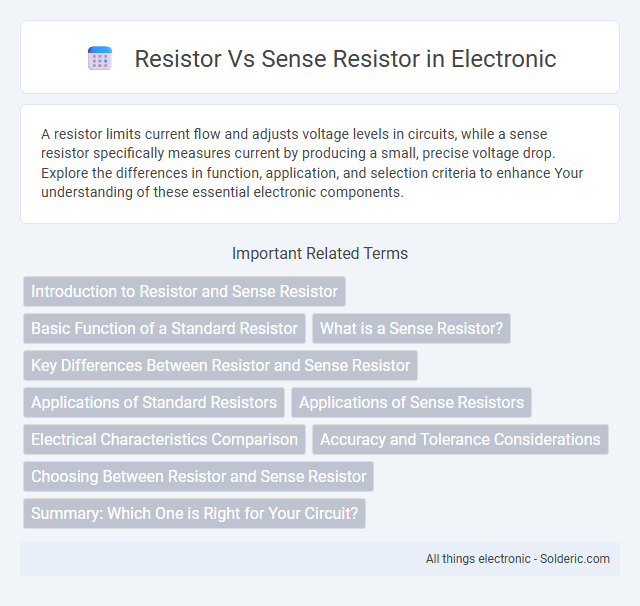A resistor limits current flow and adjusts voltage levels in circuits, while a sense resistor specifically measures current by producing a small, precise voltage drop. Explore the differences in function, application, and selection criteria to enhance Your understanding of these essential electronic components.
Comparison Table
| Feature | Resistor | Sense Resistor |
|---|---|---|
| Purpose | Limits current, divides voltage | Measures current by voltage drop |
| Resistance Value | Varies widely (Ohms to Megaohms) | Very low (milliohms to a few ohms) |
| Power Rating | Standard power ratings (0.125W to several watts) | Higher power rating for accurate measurement |
| Accuracy | General tolerance (+-1% to +-10%) | High precision (+-0.1% to +-1%) |
| Key Use Case | Current limiting, voltage division | Current sensing in power supplies, battery monitoring |
| Temperature Coefficient | Typically higher (less stable) | Low TCR (Temperature Coefficient of Resistance) |
| Placement | Anywhere in circuit | In series with load for current measurement |
Introduction to Resistor and Sense Resistor
Resistors are passive electrical components that limit current flow and divide voltage in circuits, characterized by their resistance value measured in ohms. Sense resistors, a specialized type of resistor with very low resistance, are used primarily for current sensing and measurement in feedback and control applications. Your choice between a standard resistor and a sense resistor depends on the precision and function required in your electronic design.
Basic Function of a Standard Resistor
A standard resistor primarily limits electric current and divides voltage in electronic circuits, ensuring proper operation by controlling current flow. It provides a fixed resistance value measured in ohms, converting electrical energy into heat. Unlike sense resistors, which have very low resistance for precise current measurement, standard resistors are designed for general current limiting and voltage division purposes.
What is a Sense Resistor?
A sense resistor is a precise, low-value resistor used to measure current flow by detecting the voltage drop across it, enabling accurate current sensing in electronic circuits. Unlike general resistors, sense resistors are designed with tight tolerance, low temperature coefficient, and high stability to ensure minimal impact on circuit performance. They are commonly employed in power management systems, battery monitoring, and current regulation to provide reliable feedback for control and protection mechanisms.
Key Differences Between Resistor and Sense Resistor
A resistor limits current flow and manages voltage within a circuit, while a sense resistor is specifically designed for precise current measurement with low resistance values to minimize power loss and voltage drop. Your applications require sense resistors for accurate current sensing in power management and motor control, contrasting with general resistors used for broader circuit functions. Key differences include tolerance, power rating, and placement within the circuit to optimize performance and accuracy.
Applications of Standard Resistors
Standard resistors are widely used in electronic circuits for controlling current flow, voltage division, and signal conditioning, offering precise resistance values to ensure circuit stability and performance. In contrast, sense resistors are specifically designed for current sensing applications, providing low, precise resistance to minimize power loss while enabling accurate current measurement in power supplies and battery management systems. Standard resistors find applications in biasing active components, filtering signals, and setting reference voltages across a broad range of electronic devices.
Applications of Sense Resistors
Sense resistors are designed for precise current measurement in electronic circuits, commonly used in power management, battery monitoring, and motor control applications. Their low resistance value minimizes power loss while enabling accurate voltage drop detection, critical for feedback systems and overcurrent protection. Your designs benefit from improved efficiency and reliability when integrating sense resistors for accurate current sensing and control.
Electrical Characteristics Comparison
Resistors and sense resistors differ primarily in their electrical characteristics, with sense resistors exhibiting extremely low resistance values, typically in the milliohm range, to accurately measure current without significantly affecting the circuit. Standard resistors have a wider resistance range and are designed to control current or divide voltage, often exhibiting higher power ratings and tolerances compared to sense resistors. Your selection depends on whether precise current measurement or general resistance control is required in the application.
Accuracy and Tolerance Considerations
Sense resistors are designed with low tolerance values, typically +-0.1% or better, to ensure precise current measurement accuracy in circuits. Standard resistors generally have wider tolerance ranges, such as +-1% or +-5%, making them less suitable for applications requiring exact current sensing. The high accuracy and low temperature coefficient of sense resistors minimize measurement errors and improve overall system performance in sensitive electronic designs.
Choosing Between Resistor and Sense Resistor
Choosing between a resistor and a sense resistor depends on your circuit's purpose and measurement accuracy requirements. Regular resistors primarily limit current or divide voltage, while sense resistors are precision components designed for accurate current sensing with low resistance and minimal power loss. Your decision should consider factors like tolerance, power rating, and the need for precise current monitoring in feedback or control systems.
Summary: Which One is Right for Your Circuit?
A resistor provides a fixed resistance to control current flow or divide voltage in circuits, while a sense resistor is designed with low resistance and high precision to accurately measure current by detecting voltage drop. Choosing the right component depends on your circuit's requirements: use standard resistors for general current limiting and voltage division, and sense resistors for precise current monitoring in power management and protection applications. Consider factors such as resistance value, tolerance, power rating, and accuracy to determine which resistor best suits your design needs.
resistor vs sense resistor Infographic

 solderic.com
solderic.com